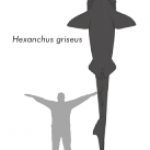sharks
There aren't any. But, aquaria have many times tried to make it so, and it always goes bad for the shark. The basic problem is that great white sharks are pelagic, and it is very hard to keep pelagic creatures in a confined space, and the largest aquaria are very confined from the point of view of a large pelagic animal.
Another problem would eventually become important in the event that an aquarium managed to keep a great white shark alive long enough. When they are young, great white sharks dine on fish. When they are adults, they seem to prefer mammals. So, imagine feeding time at the…
I love field guides. One should own a lot of field guides, not just to things you might go out in the field to see and identified, but just to browse through.
David Ebert, Sarah Fowler and Marc Dando have produced A Pocket Guide to Sharks of the World It is put out by Princeton, which does excellent guides (this is part of their Pocket Guide series).
From the Princeton site, about the authors:
David A. Ebert is the program director for the Pacific Shark Research Center and a research faculty member at Moss Landing Marine Laboratories. Sarah Fowler cofounded the UK Shark Trust and the…
Isn't something like this thought to have happened in California as well, in recent years?
tags: Brian Skerry Reveals Ocean's Glory -- and Horror, conservation, marine biology, fish, marine mammals, oceans, sharks, leatherback sea turtle, right whale, overfishing, photographer, Brian Skerry, TEDTalks, TED Talks, streaming video
Professional photographer Brian Skerry shoots life above and below the waves -- as he puts it, both the horror and the magic of the ocean. Sharing amazing, intimate shots of undersea creatures, he shows how powerful images can help make change.
TEDTalks is a daily video podcast of the best talks and performances from the TED Conference, where the world's…
The tail of a thresher shark (Alopias vulpinus). From Wikipedia.
Thanks to sensational documentaries and summer blockbusters, we are all familiar with the anatomy of a shark attack. The victim, unaware that they are in peril, is struck from below and behind with such speed and violence that, if they are not actually killed during the first strike, they soon find themselves a few pounds lighter in the middle of a billowing red cloud. The trouble is that this stereotyped scenario does not hold for all sharks, particularly one peculiar group of deepwater sharks which has long puzzled…
The jaws of C. megalodon as restored by Bashford Dean for the AMNH in 1909. Image from the American Museum Journal.
My early elementary reading school choices often got me into trouble. Every week I would pass over the recommended, grade-appropriate sections for the few shelves containing the books about dinosaurs, sharks, and alligators - if it was big and hard sharp teeth, I wanted to learn about it. The school librarian was not too pleased with this, even calling my parents in on one occasion to insist that I read something fit for younger children, but I just could not get enough of…
Anyone who follows me on twitter has probably noticed a lot of tweets about a shark fin bill that was being reviewed in Hawaii. I am glad to inform you that this historic bill has just passed the legislature. It's but a signature by Governor Lingle away from being enacted into law!
Of the 307 shark species assessed by the IUCN, 64 are listed as vulnerable, endangered or critically endangered due to shark finning. As a group, sharks represent the greatest percentage of threatened marine species on the Red List. Despite the overwhelming evidence that these majestic predators are in trouble,…
Those of you who follow me on twitter have been flooded with links about the recent United Nations meeting which included a once-every-three-years Conference of the Parties for the Convention on International Trade in Endangered Species of Wild Fauna and Flora (CITES). As a biologist, I take conservation issues quite seriously, especially when it comes to regulations. I feel that large scale efforts are not just important, they are necessary to protect species from overexploitation. Up on the slab were a number of key regulations for a variety of species, and I anxiously awaited the results…
A jar full of dogfish, photographed at the New Jersey State Museum.
A photograph and line drawing (left side) of the fossil dolphin Astadelphis gastaldii. The crescent-shaped line in the line drawing represents the bite of a large shark, with the red portions representing damage done directly to the bone. From Bianucci et al, 2010.
Shark attacks are events of speed and violence. When they have locked on to a prey item sharks seem to come out of nowhere, and though they can be quite gentle with their jaws (as on occasions when they are unsure about whether something is food or not) their ranks of serrated teeth can inflict a devastating amount of damage.…
The Maldive Islands played a crucial role in Darwin's long argument about coral reef genesis. It's nice to see them now play a crucial role in shark conservation by making the entire archipelago -- roughly the area of Maine, but warmer and wetter -- a shark sanctuary.
From Sharks receive Indian Ocean sanctuary in the Maldives - NatGeo News Watch
The Maldives has become the second nation to proclaim complete protection for sharks in its territorial waters.
The cabinet "decided to enforce the decision on banning shark hunting in the Maldives beginning from 1 March 2010. It was also decided…
Not Exactly Pocket Science is a set of shorter write-ups on new stories with links to more detailed takes by the world's best journalists and bloggers. It is meant to complement the usual fare of detailed pieces that are typical for this blog.
The rewarding side of being a psychopath
What goes on in the brains of psychopaths? They can seem outwardly normal and even charming, but tthese people typically show a lack of empathy, immoral behaviour and an impulsive streak. Joshua Buckholtz found that the last of these traits - impulsivity - may stem from a hyperactive reward system in the…
A restoration of the giant, durophagous shark Ptychodus, courtesy paleo-artist Matt Celeskey.
The study of prehistoric sharks is no easy task. Specialists in other branches of vertebrate paleontology at least have the reasonable hope of discovering complete skeletons of their subjects; except in instances of exceptional preservation the scientists who study sharks typically only have teeth and a few vertebrae to work with. Still, you can tell a lot about a shark by its teeth, and a new study published in Cretaceous Research suggests that one peculiar form was a shell-crushing giant.…
tags: conservation, endangered species, Shark Finning, Sea Shepherd, human behavior, television, streaming video
This is a television commercial by the Sea Shepherd. It is an appeal to stop finning sharks. Shark finning refers to the cruel practice of capturing sharks and slicing off their fins. Shark fins are a Chinese delicacy -- they are the main ingredient in shark fin soup. Since shark meat isn't worth the cost of transporting the massive shark bodies to market, the finless animals are thrown back into the water, alive. Without its fins, the shark cannot swim, so it sinks beneath the…
The hammerhead shark's head is one of the strangest in the animal world. The flattened hammer, known as a 'cephalofoil', looks plain bizarre on the face of an otherwise streamlined fish, and its purpose is still the subject of debate. Is it an organic metal detector that allows the shark to sweep large swathes of ocean floor with its electricity-detecting ability? Is it a spoiler that provides the shark with extra lift as it swims? All of these theories hypotheses might be true , but Michelle McComb from Florida Atlantic University has confirmed at least one other -the hammer gives the shark…
About four million years ago, in the shallows of an ocean that once covered what is now southern Peru, a large shark bit into the jaw of a baleen whale. The whale had been dead for some time, but it was kept afloat but the gases building up in its body as it decomposed. It was absolutely rotten, but it still presented a free meal to the scavenging shark. As the shark bit down, however, one of its teeth became stuck in the whale's jaw bone and broke off. No matter. The lost tooth would soon be replaced by another.
The above scenario does involve a bit of speculation, but such events certainly…
In the middle of the Pacific Ocean, Gonzalo Mucientes has discovered an invisible line in the sea that separates male mako sharks from females. The line runs from north to south with the Pitcairn Islands to its west and Easter Island to its east. On the western side, a fisherman that snags a mako will most probably have caught a male. Travel 10 degrees of longitude east and odds are they'd catch a female. This is a shark that takes segregation of the sexes to new heights.
Mucientes and colleagues from Spain, Portugal and the UK spent four months aboard a Spanish longline fishing vessel.…
I am the lead author of a new study In Hot Soup: Sharks Captured in Ecuador's Waters out in the journal Environmental Sciences. We reconstructed the shark landings for Ecuador from 1976 to 2004 and demonstrated that Ecuador captures more than 3.5 times the number of sharks they officially report catching--or about half a million sharks each year.
The shark fishery of Ecuador is one of many around the world that feeds the growing Asian demand for sharkfin soup. Fishermen catch more than 40 different shark species and one need only visit a few of the fishing ports along the coast to see shark…
The John West mascot really gets into his work (featuring a guest appearance from one of the shark puppets from Deep Blue Sea).

